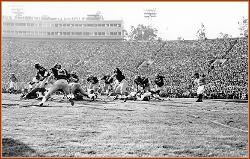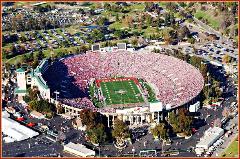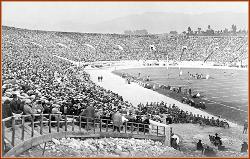



The First Game at Fenway Park
After two rain delays, Fenway Park finally hosted its first professional baseball game on April 20, 1912. (The first official game played in Fenway
actually occurred on April 9 when the Sox beat Harvard University, 2-0.) The Red Sox defeated the New York Highlanders (later known as the
Yankees) before 27,000 fans,7-6 in 11 innings. The event would have made front page news if it had not been for the sinking of the Titanic
only a few days before. Even after the Sox made Fenway their home, they didn't always play their games there. Occasionally, the Red Sox
scheduled their "big games" at Braves Field to accommodate larger crowds (like those that were over 42,000 people for Games Three and
Four of the 1915 World Series. Boston won that year, beating the Philadelphia Phillies. Fenway Park's peculiar dimensions were not intended
to provide a tempting target for home run hitters, but to keep non-paying customers out of the park. In left field, there was a steep 10-foot
embankment that ran in front of the wall where fans were allowed to sit. The Sox' Duffy Lewis was so skilled at playing balls hit to the ledge that
it became known as Duffy's Cliff.








Before Fenway
In 1901, the Boston Pilgrims became one of the founding teams in the American
League. The Pilgrims played at the Huntington Avenue Grounds, now a part of
Northeastern University's campus. Boston Globe owner General Charles Henry
Taylor, a Civil War veteran, bought the team for his son John I. Taylor in 1904. In
1907, owner Taylor changed the club's name from the Pilgrims to the Red Sox. In
1910, tired of the leasing arrangement for the Huntington Avenue Grounds, Taylor
made a big announcement: he would build a new ballpark for his Red Sox. Taylor
dubbed the new ballpark Fenway Park because of its location in the Fenway section
of Boston.
Birth of the Green Monster
Fenway Park remained unchanged until a May 8, 1926 fire destroyed part of the park.
John Quinn, the owner at the time, simply charted the remains out of the park;
because of a lack of funds, he didn't bother to rebuild the bleachers. Left fielders
didn't complain, because this allowed them to be able to catch foul balls for outs
behind the stands. Tom Yawkey, who bought the club in 1933, began a major remake of the park. The project, however, came to a screeching
halt on January 5, 1934 when a second fire ravaged the building for five hours. Few areas of the ballpark were left undamaged. Construction
crews worked diligently to reconstruct the ballpark in time for the season opener on April 17, 1934. When Fenway Park's gates opened on that
day, it had a new look. Concrete bleachers replaced the wood bleachers in centerfield. Duffy's Cliff was leveled off, though not completely. And
the 37-foot wooden left field wall was replaced by a more durable, 37-foot sheet metal structure. In 1936, a 23-1/2-foot tall screen was added on
top of the wall to better protect the windows of buildings on Lansdowne Street. When the wall's advertisements were covered by green paint in
1947, Fenway Park's signature feature — the Green Monster — was born.
Bullpens named Williamsburg
Three years later, Ted Williams, a dead-pull left-handed hitter, came to Boston. The
following year, 1940, bullpens were constructed in right field to bring the fence 23 feet
closer to home plate for Williams. The new bullpens appropriately became known as
Williamsburg. The ballclub installed skyview seats at Fenway Park in 1946. Lights
followed in 1947, and Fenway's first message board in was added over the centerfield
bleachers in 1976. In 1988-89, stadium club seats were constructed above grandstand
behind home plate, where the former press box was located. Other than those additions,
Fenway Park for the most part is unchanged. With its manually operated scoreboard, its
geometrically peculiar shape (including the only ladder in play in the majors) and the
stories of the legends that have played there for more than eight decades, Fenway
remains a link to the legends of baseball's past. On any given night at Fenway Park,
there's no telling what you might see: a living legend may homer in his last at bat, a
pitcher named "Smokey" live up to his name, or a catcher from New Hampshire hit a ball
just fair past the left field foul pole into the cool October night.

The Red Seat
The lone red seat in the right field bleachers (Section 42, Row 37, Seat 21),
signifies the spot where the longest measurable home run ever hit inside Fenway
Park landed. Ted Williams hit the home run on June 9, 1946 off Fred Hutchinson
of the Detroit Tigers. Williams' bomb was officially measured at 502 feet (153 m)
— well beyond "Williamsburg". According to Hit Tracker Online, the ball, if
unobstructed, would have flown 520 to 535 feet.
The ball landed near the head of one Joseph A. Boucher, who was supposedly
taking a nap at the time, penetrating his large straw hat and hitting him in the
head. A confounded Boucher was later quoted as saying "How far away must one
sit to be safe in this park? I didn't even get the ball. They say it bounced a dozen
rows higher, but after it hit my head, I was no longer interested. I couldn't see the
ball. Nobody could. The sun was right in our eyes. All we could do was duck. I'm
glad I didn't stand up."
No other player at Fenway Park has ever hit that seat since, although on June 23,
2001 Manny Ramirez hit two home runs; one measuring 463 feet and another one
that was said to have travelled 501 feet. The 501 foot blast struck a light tower
and the official estimate deferred to Williams' record, placing Ramirez's home run
exactly one foot short.

The Fisk Foul Pole
In a ceremony before the Red Sox's 2005 interleague game against the Cincinnati Reds, the pole on
the left field foul line atop The Green Monster was named Fisk Foul Pole, in honor of Carlton "Pudge"
Fisk. Fisk provided one of baseball's most enduring moments in Game 6 of the 1975 World Series
against the Reds. Facing Reds right-hander Pat Darcy in the 12th inning with the score tied at 6–6,
Fisk hit a long fly ball down the left field line. It appeared to be heading foul, but Fisk, after initially
appearing unsure of whether or not to continue running to first base, famously jumped and waved his
arms to the right as if to somehow direct the ball fair. It ricocheted off the foul pole, winning the game
for the Red Sox and sending the series to a seventh and deciding game the next night.

Duffy's Cliff
From 1912 to 1933, there was a 10-foot-high incline in front of the then 25-foot high left field wall at Fenway Park, extending from the left-field
foul pole to the center field flag pole. As a result, a left fielder in Fenway Park had to play part of the territory running uphill (and back down).
Boston's first star left fielder, Duffy Lewis, mastered the skill so well that the area became known as "Duffy's Cliff".
The incline served two purposes:
1. It was a support for a high wall; and
2. It was built to compensate for the difference in grades between the field and Lansdowne Street on the other side of that wall.
It also served as a spectator-friendly seating area during the dead-ball era when overflow crowds would sit on the incline behind ropes. It is
often compared to the infamous left field "terrace" at Cincinnati's Crosley Field, but, in truth, the 15-degree all-grass incline there served an
entirely different purpose: as an alternative to an all dirt warning track found in most other ballparks. It was a natural feature of the site on which
Crosley Field and its predecessors were located; slightly less severe inclines were deliberately built in center and right fields to compensate.
The incline in center field of Minute Maid Park has been considered a tribute to Duffy's Cliff.
As part of the 1934 remodeling of the ballpark, the bleachers and the wall itself, Red Sox owner Tom Yawkey arranged to flatten the ground
along the base of the wall, so that Duffy's Cliff no longer existed, and thus became part of the lore of Fenway Park. Thus the base of the left
field wall is several feet below the grade level of Lansdowne Street, accounting for the occasional rat that might spook the scoreboard
operators. ("The Fenway Project", ISBN 1-57940-091-4.)
For decades there was considerable debate about the true left field distance, which was posted as 315 feet (96 m). For years, Red Sox officials
refused to remeasure the distance. Reportedly, the Boston Globe was able to sneak into Fenway Park and remeasure the line. When the
paper's evidence was presented to the club in 1995, the line was finally remeasured by the Red Sox and restated at 310 feet (94.5 m). The
companion 96 meters sign remained unchanged, until 1998, when it was corrected to 94.5 meters. A theory about the incorrect foul line
distance is that the former 315 ft (96 m) measurement came from the Duffy's Cliff days. That measurement likely included the severity of the
incline, and when the mound was leveled, the distance was never corrected. A quick study of the geometry of "Duffy's Cliff" suggests the theory
has merit. Regardless of the posted distance, frustrated pitchers will always argue that "The Green Monster" is closer than the sign says.
Pesky's Pole
Pesky's Pole is the name for the pole on the right field foul line, which stands a mere 302 feet from home plate, the shortest right field porch in
Major League Baseball. The pole was named after Johnny Pesky, a light-hitting shortstop for the Red Sox, who hit some of his six home runs
at Fenway Park around the pole but never off the pole. Pesky and the Red Sox give credit to pitcher Mel Parnell for coining the name. The
most notable for Pesky is a two-run homer in the eighth inning of the 1946 Opening Day game to win the game. (In his career, Pesky hit 17
home runs.) In similar fashion, Mark Bellhorn hit what proved to be the game-winning home run off of Julián Tavárez, in Game 1 of the 2004
World Series off that pole's screen.
On September 27, 2006, on Pesky's 87th birthday, the Red Sox organization officially dedicated the right field foul pole as Pesky's Pole with a
commemorative plaque placed at its base.
EMC Club (previously the .406 Club & 600 Club)
In 1983, private suites were added to the roof behind home plate. In 1988, 610 stadium club seats enclosed in glass and named the "600
Club", were added above the home plate bandstand, replacing the existing press box. The press box was then added to the top of the 600
Club. The 1988 addition is largely credited with changing the air currents in Fenway Park to the detriment of hitters. In the 1980s, an MIT
professor published his scientific finding that the addition does, in fact, curtail home runs at Fenway Park, giving credence to that claim by
players, coaches, and fans, most notably Wade Boggs.
In 2002, the organization renamed the club seats the ".406 Club" (in honor of Ted Williams' batting average in 1941), six days after his death.
(Williams is the last player to hit .400 or better to finish a season in the major leagues.)
During the fall and winter of 2005-2006, as part of the continuing expansion efforts at Fenway Park, the existing .406 club was rebuilt. The
second deck now features two open-air levels: the bottom level is the new "EMC Club" featuring 406 seats and concierge services, and above
that, the State Street Pavilion, with 374 seats and a dedicated standing room area. The added seats are wider than the previous seats. All
work was done by D'Agostino Izzo Quirk Architects of Somerville, MA.















